
By Judith Elaine Halek
Photos and Article Copyright @ 2000 Judith Elaine Halek
I was sitting at a dinner table with a group of women in their late thirties and forties. I, myself, am in my early forty’s, not married, been working in the birth modalities for the past twelve years and at present, am not seeing anyone in particular. I commented, “I don’t think it’s in the cards for me to have a baby this lifetime.””Really!” exclaimed a couple of the women. “How old are you?” inquired one woman. “Close to my mid forties.” I responded. “Oh, that won’t be a problem,” she said matter of factly, “You can always do invitro, or donor insemination.” I looked at her and then to other women around the table as all eyes were set on my response. I was surprised and disappointed that conception has become a casual ‘technocratic procedure’ in the minds of the public. I began to explain IVF and donor insemination requires massive douses of antibiotics, a large bank account, arranging one’s work schedule around clinic visits, undergoing countless invasive, often painful, always emotionally charged procedures, all for the chance that I might be the one of ten to be blessed with the news of a cyborg conception. Please understand, I am not judging anyone who chooses this path of conception. It is not my preference of choice and thank goodness, we still have a choice.
Or do we? When I reflect back on my experiences the past twelve years as a labor support specialist, childbirth educator, birth counselor, massage therapist, yoga instructor I’ve found far too many women who did not exercise their options of choice and gave their power away to the medical caregivers, especially in hospitals. After attending over 100 births in hospitals, birth centers and homes, I have had the opportunity to experience a variety of possibilities. It is my vision, that all labor and delivery nurses and obstetricians witness 30 home births or birth center births as part of their medical training.
|
I remember at one hospital, a nurse commented, “Having a baby at home is one of the most dangerous experiences a mother could put her baby and herself through.” I asked if she had ever attended a home birth, or studied the statistics of home birth practices. She admitted she had not attended a one or knew anything about recent studies on home birthwith midwife practices. I asked her, as I’ve asked many people who make blanket statements without any information to back up their claims, “How can you make such a definitive comment when you’ve not any experience with what you are judging?” |
It’s rather ironic that we in our intellectual aspects, read, watch videos, attend classes, surf the internet, express our gathering feminine nature, becoming an ‘informed consumer’, yet when it all comes down to the real deal, one of my favorite mentors, Dr. Michel Odent states, “Forget the books, tapes, videos. Go to a quiet, dark place, private and safe, trust the process, surrender to your bodies and have your babies.”
I believe women have forgotten how to birth, trust, listen, go deep inside and communicate with their bodies and their babies. I also believe women can remember.
What are the choices, options, for non-technocratic pregnancies, labors and births? I have been an advocate of midwifery for the past 12 years. After researching international statistical outcomes regarding midwifery vs. obstetrical care, midwives have far exceeded the lower infant mortality rates, fewer medical interventions and higher results in more empowering births.
been an advocate of midwifery for the past 12 years. After researching international statistical outcomes regarding midwifery vs. obstetrical care, midwives have far exceeded the lower infant mortality rates, fewer medical interventions and higher results in more empowering births.
Having a baby with an obstetrition in a hospital? Create a birth plan, a “guide line,” toward the ideal birth you would like to create. Birth plans are generally discussed in your childbirth classes. Look in various childbirth books early on in your pregnancy and begin to educated yourself. A few favorites are, “The Birth Book” by Sears and Sears, MD, “The Complete Book for Pregnancy and Childbirth,” by Sheila Kitzinger and “New Active Birth, a Complete Guide to Natural Childbirth,” by Janet Balaskas. To find out about midwifery based practices in your area, call American College of Nurse Midwives, (ACNM,): 202-728-9860 (general number), 1-888-643-9433, (toll free locator number). Or contact Midwives Alliance of North America, (MANA): 1-888-923-6262.
Bring questions to your medical caregivers, be attentive how they respond. If you experience not being heard or rushed through prenatal visits, go over in your mind and with your partner why you don’t feel supported. If you do your work early on, talking further or switching medical caregivers will not be as problematic.
Over and over I have encouraged women to trust your highly sensitized instincts, do research and own this birth. This labor and birth will only happen once and it’s vital to be with people you feel safe, listened to and trust. I believe, the only way change will take place among the obstetrical practices is through the public. By asking for what you deserve, you educate and introduce the medical profession to another possibility.
Another alternative is a labor support doula. A ‘doula’ is a Greek word for ‘woman assistant.’ She meets with a couple and gathers information prentally. She’s on call before and after the due date, attending to the parents needs during early and later stages of labor and birth, following up with a post-natal visit after the birth. Doulas have statistically proven to lower cesarean sections by 50%, length of labor down 25%, oxytocin use, down 40%, pain medications (narcotics) down 30%, forceps down 30%, and epidurals down 60%. A labor doula is by no means to replace the partner of the mother. No one can replace the relationship or connection of a woman’s partner. The doula helps to relieve the pressure and enhance the experience.
Since 1993, when Doulas of North America, (DONA,) began a certification program there are now over 8,000 certified. For referrals call, 206-324-5440. Book referrals for becoming a doula: “The Birth Partner,” by Penny Simkin, PT, “Mothering The Mother,” by M. Klaus, MD , J. Kennel, MD and Phyllis Klaus, M.Ed., CSW. If someone would be interested in setting up a doula program read, “Doula Programs: How to Start and Run Private or Hospital-Based Programs with Success!,” by Paulina Perez and Deaun Thelen.
An aquatic analgesic alternative to medical pain medication or an epidural is water labor or water birth. As the east coast resource center for water birth, my organization, Birth Balance, has educated countless couples on this unique and growing approach. A shower is great during labor, yet, it can’t compare to submerging half to three quarters of your body in a tub of water. Advantages to water birth for the mother are: easier coping during dilatation of the cervix and the pushing stage, softening of the perennial tissues, bones, muscles so lacerations are minimal, ability to move in whatever position her body organically discovers, less interventions, faster labors and births. Advantages to the baby: a medium which softens the baby’s bones and tissues thus creating a softer birth experience, babies appear to be less traumatized, a drug free beginning and more immediate bonding with mother.
 A concern regarding water labor or birth is infection. When in the water, bacteria is diluted. Unless someone enters the water with an infection of some sort offering foreign bacteria, there wouldn’t be problems with the mothers infecting herself or the baby. A study in 1996 of 1385 women with prelabor rupture of the membranes after 34 weeks gestation concluded a tub bath did not increase the risk of maternal or neonatal infection after premature rupture of the membranes and prolonged latency. (1)
A concern regarding water labor or birth is infection. When in the water, bacteria is diluted. Unless someone enters the water with an infection of some sort offering foreign bacteria, there wouldn’t be problems with the mothers infecting herself or the baby. A study in 1996 of 1385 women with prelabor rupture of the membranes after 34 weeks gestation concluded a tub bath did not increase the risk of maternal or neonatal infection after premature rupture of the membranes and prolonged latency. (1)
Another randomized, controlled trial was with 785 women. The results were as follows: tub group required fewer pharmacological agents, fewer deliveries by forceps and vacuum, more likely to have intact perineum and an overall positive effect on analgesic requirements, instrumentation rates, condition of the perineum and personal satisfaction. (2)
Another concern people have is the drowning of the baby at birth. The baby is in a womb of water from conception and is born into an extended womb of water later. The baby receives oxygen from the umbilical cord which is attached to the placenta. As the baby is born, the placenta is detaching from the mother, thus the supply of oxygen becomes depleted and bringing the baby up to the surface as soon as possible is imperative. Another atmospheric pressure, such as air or gravity is what stimulates the babies chemoreceptors to take a breath. That is why, in water, the baby will not take a breath.
Water birth has been around for centuries. In the contemporary times the concept began in Russia in the 60’s,, spread to France, England in the 70’s and come to the United States in the 80’s. For further reading on the subject check out: (book and video) “Gentle Birth Choices,” by Barbara Harper, RN, “Water Birth, A Midwife’s Perspective,” by Susanna Napierala and “The Waterbirth Handbook, ” by Dr. Roger Lichy and Eileen Herzberg.
No matter what choices you make for this birth or future, each pregnancy, labor and birth will teach you what to do differently or the same the next time. Remember, everything is an opportunity for learning. Keep an open mind and heart and learn.
(1), (2): MIDIRS Midwifery Digest, (Mar 1997) 7:1.

 BB © 2013
BB © 2013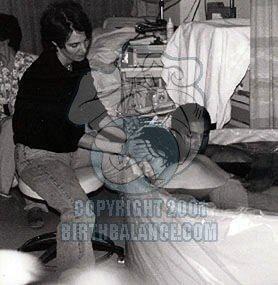 During the early 1980s, Estelle Myers, at the Rainbow Dolphin Centre in New Zealand, led the first two waterbirth conferences.
During the early 1980s, Estelle Myers, at the Rainbow Dolphin Centre in New Zealand, led the first two waterbirth conferences. Doula Linda Cohen in Long Island, New York devised a rather simple recipe for situations in the hospital where the mother is not allowed anything but ice chips and water. She calls this “The Drizzle.” In a cup add: a bit of infused (very strong) hot red raspberry leaf tea and a teaspoon of honey; mix thoroughly and add ice chips. Feed to mother with a spoon while in the tub, on the birth throne (toilet), on a bed, kneeling over a physioball, walking down the hall or up and down stairwells. Once I was fortunate enough to be invited to a home birth with a small group of Russians from Moscow. I saw a small bowl of fresh cranberries on the side of the tub. Periodically the mother would suck on one, put it back in the bowl and go through the contraction. Sucking the cranberries, the mother claimed, helped stimulate her thirst. As an assistant, I periodically ask the mother if the water feels too cool or too warm. Placing a small thermometer in the tub helps monitor the temperature. If the water is too hot and the mother desires it to be even warmer, I suggest she get out of the water and walk. If the water became too cold I would add hot water away from the mother if she remains in the tub or get her out of the tub and add the water. Another trick the Russians taught me is, if the mother is feeling too warm in the tub yet doesn’t want to get out, she can hold onto pieces of ice to cool down, or sit along the edge of the tub with her feet still in the water. Barbara Harper explains: “The greatest benefit to immersion will be experienced in the first hour to two hours. Twenty minutes in the bath is not enough for the physiologic responses to work effectively. That is why some women, both primips and multips, get into the water at 7 cm or 8 cm dilation and begin to experience pushing urges within the first hour of immersion.”
Doula Linda Cohen in Long Island, New York devised a rather simple recipe for situations in the hospital where the mother is not allowed anything but ice chips and water. She calls this “The Drizzle.” In a cup add: a bit of infused (very strong) hot red raspberry leaf tea and a teaspoon of honey; mix thoroughly and add ice chips. Feed to mother with a spoon while in the tub, on the birth throne (toilet), on a bed, kneeling over a physioball, walking down the hall or up and down stairwells. Once I was fortunate enough to be invited to a home birth with a small group of Russians from Moscow. I saw a small bowl of fresh cranberries on the side of the tub. Periodically the mother would suck on one, put it back in the bowl and go through the contraction. Sucking the cranberries, the mother claimed, helped stimulate her thirst. As an assistant, I periodically ask the mother if the water feels too cool or too warm. Placing a small thermometer in the tub helps monitor the temperature. If the water is too hot and the mother desires it to be even warmer, I suggest she get out of the water and walk. If the water became too cold I would add hot water away from the mother if she remains in the tub or get her out of the tub and add the water. Another trick the Russians taught me is, if the mother is feeling too warm in the tub yet doesn’t want to get out, she can hold onto pieces of ice to cool down, or sit along the edge of the tub with her feet still in the water. Barbara Harper explains: “The greatest benefit to immersion will be experienced in the first hour to two hours. Twenty minutes in the bath is not enough for the physiologic responses to work effectively. That is why some women, both primips and multips, get into the water at 7 cm or 8 cm dilation and begin to experience pushing urges within the first hour of immersion.”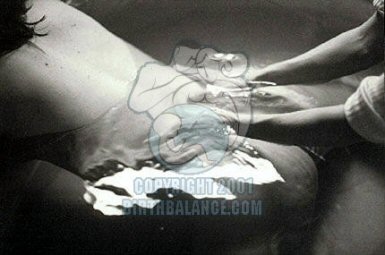 In Bristol, two women who had adverse perinatal outcomes had labored for more than seven hours in the birthing pool. There was one stillborn child with evidence of asphyxia and one baby with severe hypoxic-ischaemic encephalopathy. These women had labored, not birthed in the water. In neither case was any specific cause evident.
In Bristol, two women who had adverse perinatal outcomes had labored for more than seven hours in the birthing pool. There was one stillborn child with evidence of asphyxia and one baby with severe hypoxic-ischaemic encephalopathy. These women had labored, not birthed in the water. In neither case was any specific cause evident. 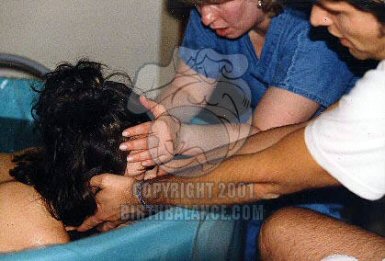 In regard to the physiology of birth, each woman responds differently to pain, yet when mothers get into the water, there is a universal, “AhhhhŠoh my god, why did I wait so long!” After the tenth person responded with the exact words, I wondered if I was experiencing the “hundredth monkey” concept. Barbara Harper, director of Global Maternal Child/Health Association, reports on her survey of close to 2,000 women, when asked the question, “What feelings do you recall?”‹almost 100 percent of women stated in one form or another they were relaxed, calm, at peace in the water.
In regard to the physiology of birth, each woman responds differently to pain, yet when mothers get into the water, there is a universal, “AhhhhŠoh my god, why did I wait so long!” After the tenth person responded with the exact words, I wondered if I was experiencing the “hundredth monkey” concept. Barbara Harper, director of Global Maternal Child/Health Association, reports on her survey of close to 2,000 women, when asked the question, “What feelings do you recall?”‹almost 100 percent of women stated in one form or another they were relaxed, calm, at peace in the water. 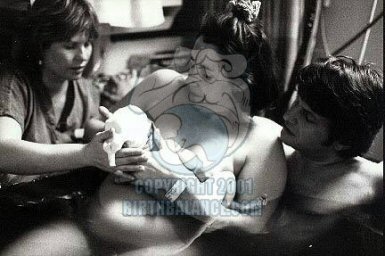
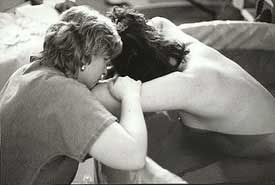


 The argument for delayed cord clamping is often used as a springboard for those who believe in lotusbirthing, a more extreme version of delayed cord clamping.
The argument for delayed cord clamping is often used as a springboard for those who believe in lotusbirthing, a more extreme version of delayed cord clamping.
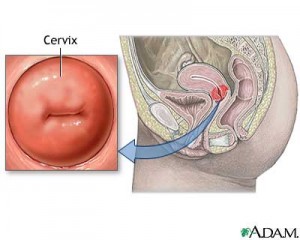 “I think it’s a good and empowering thing for a woman to check her own cervix for dilation. This is not rocket science, and you hardly need a medical degree or years of training to do it. Your vagina is a lot like your nose- other people may do harm if they put fingers or instruments up there but you have a greater sensitivity and will not do yourself any harm.
“I think it’s a good and empowering thing for a woman to check her own cervix for dilation. This is not rocket science, and you hardly need a medical degree or years of training to do it. Your vagina is a lot like your nose- other people may do harm if they put fingers or instruments up there but you have a greater sensitivity and will not do yourself any harm. “The best way to do it when hugely pregnant is to sit on the toilet with one foot on the floor and one up on the seat of the toilet. Put two fingers in and go back towards your bum. The cervix in a pregnant woman feels like your lips puckered up into a kiss. On a non-pregnant woman it feels like the end of your nose. When it is dilating, one finger slips into the middle of the cervix easily (just like you could slide your finger into your mouth easily if you are puckered up for a kiss). As the dilation progresses the inside of that hole becomes more like a taught elastic band and by 5 cms dilated (5 fingerwidths) it is a perfect rubbery circle like one of those Mason jar rings that you use for canning, and about that thick.”
“The best way to do it when hugely pregnant is to sit on the toilet with one foot on the floor and one up on the seat of the toilet. Put two fingers in and go back towards your bum. The cervix in a pregnant woman feels like your lips puckered up into a kiss. On a non-pregnant woman it feels like the end of your nose. When it is dilating, one finger slips into the middle of the cervix easily (just like you could slide your finger into your mouth easily if you are puckered up for a kiss). As the dilation progresses the inside of that hole becomes more like a taught elastic band and by 5 cms dilated (5 fingerwidths) it is a perfect rubbery circle like one of those Mason jar rings that you use for canning, and about that thick.”

